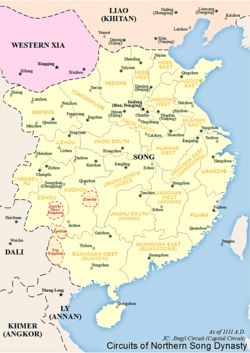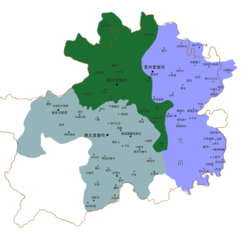Chiefdom of Sizhou
 From Wikipedia - Reading time: 5 min
From Wikipedia - Reading time: 5 min
Chiefdom of Sizhou 思州土司 | |||||||
|---|---|---|---|---|---|---|---|
| 582–1413 | |||||||
 Chiefdom of Sizhou in 1100 A.D. (Tianshi = Chiefdom of Sizhou) | |||||||
 Sizhou in purple and Bozhou in green | |||||||
| Status | Native Chiefdom of China | ||||||
| Capital | Sizhou (modern Cengong) | ||||||
| Common languages | Tujia, Chinese, Hmong | ||||||
| Religion | Nuoism, later also Confucianism | ||||||
| Government | Monarchy | ||||||
| Chieftain | |||||||
• 582–626 | Tian Zongxian (first) | ||||||
• 1387–1413 | Tian Chen (last) | ||||||
| History | |||||||
• Established | 582 | ||||||
• independence of Sinan | 1364 | ||||||
• Annexed by Ming China | 1413 | ||||||
| |||||||
| Today part of | China | ||||||
Chiefdom of Sizhou (Chinese: 思州土司; pinyin: Sīzhōu Tǔsī), ruled by the Tian clan, was an autonomous Tusi chiefdom established by Tian Zongxian (田宗顯) during the Sui dynasty. After he conquered the Qianzhong area (present-day eastern Guizhou Province), Tian Zongxian was recognized as the hereditary ruler of the region by the Sui court in 582.
Sizhou, Bozhou, Shuidong and Shuixi were called "Four Great Native Chiefdom in Guizhou" (贵州四大土司) by Chinese.[1] "Liangguang [ruled by] Cen and Huang, Sizhou and Bozhou [ruled by] Tian and Yang" (Chinese: 两广岑黄,思播田杨; pinyin: Liǎngguǎng Cén Huáng, Sī Bō Tián Yáng), an idiom current among Southwestern Mandarin speakers, proved that the Tian clan was once one of the most powerful clans in Southwestern China.[2]
Origin
[edit]The Tian clan claimed to be descendants of Han Chinese in their genealogy book; however the authenticity needed to be verified. Modern scholars stated that Tian Zongxian was either Han Chinese[2] or Tujia.[3]
History
[edit]The Chiefdom of Sizhou was established during the Sui dynasty when the first chieftain Tian Zongxian occupied Qianzhong area (黔中, modern-day eastern Guizhou) in southwest China. It lasted for about 831 years over 26 generations through the Sui, Tang, Song, Yuan, and Ming dynasties.[2][4]
In 1107, Sizhou chieftain Tian Yougong (田祐恭) acquiesced Song dynasty's overlordship, Sizhou came under the Chinese jimi system. In 1273, Sizhou surrendered to Yuan dynasty and came under the Chinese tusi system.[5]
In 1364, Chiefdom of Sinan declared its independence from Sizhou. Tian Mao'an (田茂安), the Sinan chieftain, swore allegiance to Ming Yuzhen, while Sizhou came under Zhu Yuanzhang's tusi system. Sizhou attacked Sinan in 1367, killed Tian Mao'an's two sons, disturbed his ancestors' tombs. Tian Mao'an died soon after this battle, his successor Tian Renzhi (田仁智) switched allegiance to Ming court, Zhu Yuanzhang ordered them to cease fire.[3][4]
However, the two clans had been feuding ever since, they were waging an endless war. Sizhou attacked Sinan in 1411, Tian Zongding (田宗鼎), the Sinan chief, was defeated and fled to Ming court for help. Five thousand Ming troops under general Gu Cheng (顧成) marched towards Sizhou and had it conquered. Tian Chen (田琛), the last Sizhou chieftain, was captured and executed in Beijing. Later, Tian Zongding was also found guilty (matricide) and executed in 1413.[6] In the same year, Guizhou Province was created,[7] both Sizhou and Sinan were fully annexed into the central bureaucratic system of the Ming dynasty.[5]
List of Sizhou chieftains
[edit]Below are Sizhou chieftains[3][4]
| No. | Name | Chinese | Reign | Notes |
|---|---|---|---|---|
| 1 | Tian Zongxian | 田宗顯 | 582–626 | |
| 2 | Tian Weikang | 田惟康 | 626–660 | eldest son of Tian Zongxian |
| 3 | Tian Yangming | 田陽明 | 660–? | eldest son of Tian Weikang |
| 4 | Tian Kechang | 田克昌 | ?–711 | son of Tian Yangming |
| 5 | Tian Daoyuan | 田道元 | 711–729 | eldest son of Tian Kechang |
| 6 | Tian Gongrong | 田公榮 | 729–773 | son of Tian Daoyuan |
| 7 | Tian Zailong | 田載龍 | 773–? | son of Tian Gongrong |
| 8 | Tian Shifeng | 田時豐 | ?–870 | son of Tian Zailong |
| 9 | Tian Zuoyu | 田佐禹 | 870–? | third son of Tian Shifeng |
| 10 | Tian Fengxiang | 田鳳翔 | ?–? | son of Tian Zuoyu |
| 11 | Tian Chengwen | 田承文 | ?–? | eldest son of Tian Fengxiang |
| 12 | Tian Zhengyun | 田正允 | ?–? | son of Tian Chengwen |
| 13 | Tian Shiru | 田士儒 | ?–1098 | son of Tian Zhengyun |
| 14 | Tian Yougong | 田祐恭 | 1098–1135 | eldest son of Tian Shiru |
| 15 | Tian Rurui | 田汝瑞 | 1135–? | eldest son of Tian Yougong |
| 16 | Tian Zuheng | 田祖衡 | ?–1224 | eldest son of Tian Rurui |
| 17 | Tian Zonghan | 田宗翰 | 1224–? | son of Tian Zuheng |
| 18 | Tian Qingyu | 田慶裕 | ?–1275 | son of Tian Zonghan |
| 19 | Tian Xinglong | 田興隆 | 1275–? | son of Tian Qingyu |
| 20 | Tian Yingbing | 田應丙 | ?–1278 | eldest son of Tian Xinglong |
| 21 | Tian Jingxian | 田景賢 | 1278–? | also known as Tian Jinxian (田謹賢) son of Tian Yingbing |
| 22 | Tian Weiyong | 田惟墉 | ?–1365 | eldest son of Tian Jingxian |
| 23 | Tian Maolie | 田茂烈 | 1365–? | son of Tian Weiyong |
| 24 | Tian Renhou | 田仁厚 | ?–1369 | eldest son of Tian Maolie Sinan declared independence in 1364 |
| 25 | Tian Hongzheng | 田弘政 | 1369–1387 | son of Tian Renhou |
| 26 | Tian Chen | 田琛 | 1387–1413 | son of Tian Hongzheng executed by Yongle Emperor in 1413 |
References
[edit]- ^ 颜丙震 (June 2018). 明后期黔蜀毗邻地区土司纷争研究 (in Chinese). ISBN 9787511555625.
- ^ a b c "思州土司的前世今朝:田氏传奇八百年 土司文化传后代" (in Chinese). people.com.cn.
- ^ a b c 黄透松 (1991). "思州田氏世系初考". 贵州文史丛刊 (in Chinese) (1).
- ^ a b c 瞿政平. "铜仁古代史与思州田氏土司" (in Chinese). 铜仁日报.
- ^ a b "田氏思州三驻龙泉坪" (in Chinese). trxw.gov.cn. Archived from the original on 2019-12-17. Retrieved 2019-12-20.
- ^ "Taizong Shilu". Ming Shilu (in Chinese). Vol. 137.
- ^ "历史沿革". People's Government of Guizhou Province. Retrieved 20 December 2019.
 KSF
KSF